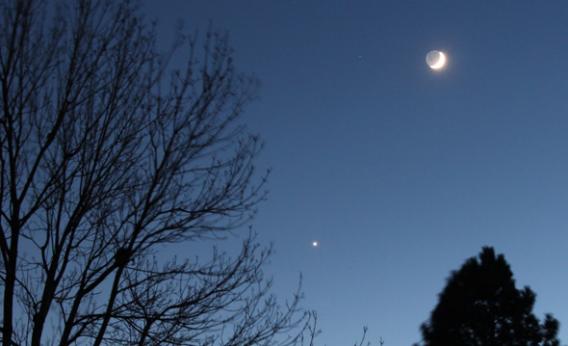Create a free profile to get unlimited access to exclusive videos, sweepstakes, and more!
Astrophoto: The Moon and Venus, Sitting in a Tree

Last night, the monthly cycle of the Moon swung it past Venus. The two were about 8° apart (roughly 15 times the Moonâs diameter), making them a lovely pair in the twilight sky.
I took the picture above from my front yard; itâs a 2.5 second exposure, enough to show the sky as still a little blue even though it was much darker to the eye (click the pictures to see them in higher-res). The Moon was a thin crescent, just four days past new.
The lit part is overexposed, so you can see some faint features on the âdarkâ side. This phenomenon is called Earthshine, because itâs actually the lunar landscape lit up by light reflected from the Earth! If you were on the Moon, the Earth would be nearly full, much larger and more than 50 times brighter than the full Moon is in our sky. Thatâs enough to gently illuminate the dark moonscape.
This next one is a shorter exposure, one second, so the sky looks better.
You can see the Earthshine a little better, perhaps, and trace out some of the features on the Moon that will get sunrise over the next week or so. A day on the Moon is a month long, with two weeks between sunrise and sunset. The pace is a bit slower on our faithful companion.
The last picture is a longer exposure, and may look a little odd:
This was a 20 second exposure. In that time, fainter stars show up, but the sky still looks blue! Both the stars and the skyâs light built up in the camera detector, so it looks like a weird composite of day and night. But by this time it was quite dark out.
The stars you see are part of the constellation Sagittarius (the brightish one to the left of the Moon is Polis, and the bright star hiding in the branches is Kaus Borealis, aka Lamba Sagittarii). When I first saw this image, I saw that blurry thing between Venus and the Moon, and thought it was a smudge or blurred star. But when I checked my star map (to look up the star names) I laughed: Thatâs the Lagoon Nebula!
The Lagoon is one of the brightest and loveliest star-forming gas clouds in the sky, and itâs an easy object for binoculars. It turned up in my short, 20 second picture quite by surprise. I alerted folks to it last night, so I hope some people were able to get some pictures. A longer exposure, guided to prevent the stars from smearing due to the Earthâs rotation, would be a very pretty shot indeed.
My camera is relatively new to me (itâs a Canon T4i, and I was using an 18-135 mm lens, FYI) so Iâm still figuring it out. Getting it to focus well on night sky objects is still something of a chore, but Iâm hoping to get the hang of it soon. I literally ran outside with the camera when I looked out my office window and saw our two solar system neighbors â Venus is the second closest object to us, after the Moon. So these were really just quick snapshots.
When I was a kid, in high school, I used up my newspaper delivery money buying film and chemicals to shoot my own astrophotos. Things are a whole lot easier now. Still, if you want to do things right, it takes knowledge, experience, patience, and a bit of an artistic flair. Iâm still learning, but Iâm excited about what I may yet be able to do.














